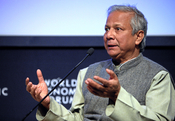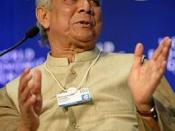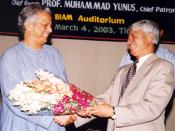Institutions around the world trace their origins back more than 50 years but it took prof. Yunus to give an institutional shape in Bangladesh and turn into a development philosophy. Meeting the Credit needs of the poor by private persons is a practice as old as the ocean or mountain but institutionalized philanthropy is definitely a new approach. Prof. Yunus began distributing small loan in Jobra village, "the Dheki Rin Prakolpa" initiated by Bangladesh Bank in collaboration with the Swanirvar Bangladesh. But it was not until 1983 that he could institutionalize it. At that time, it was difficult to conceive that these initiatives would lead to major microcredit movement, which would make Bangladesh known to the rest of the world and emerge as a model. The most conspicuous event in this regard was Microcredit Summit of February 1997, attended by 2900 delegates from 137 countries where Prof. Yunus said, "We believe that property does not belong to a civilized human society.
It belongs to museums. This summit is about creating a process, which will send poverty to the museums. We will create a poverty-free world". Bangladesh Government is also committed to see a poverty-free country.
The Problems of Micro-Credit:Grameen in Bangladesh and SEWA in India are example of microcredit schemes that encourage women's participation. Both have seen some big successes, so it's no wonder that so much is expected.
Still, we need to ask what micro-credit really means for poor women? Just how far does it go towards alleviating poverty? Are all participating NGOs indeed following in the footsteps of SEWA and Grameen?Not everyone has hoped on the micro-credit bandwagon. The following viewpoint, excerpted from "Micro-Credit: Band-Aid or Wound"? by Kavaljit Singh, Nan Dawkins-Scully and Daphne Wysham, explores some of the downside of micro-credit:A global campaign to...


